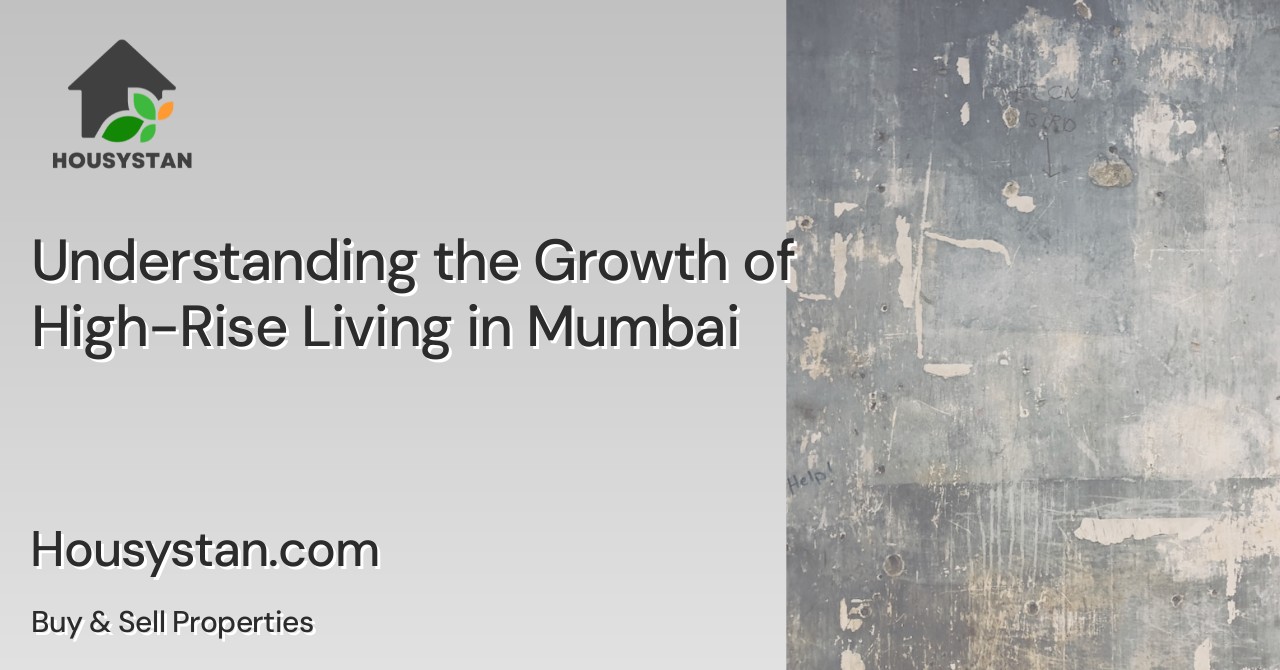Understanding the Growth of High-Rise Living in Mumbai
Read latest blogs and articles from Housystan

The Information mentioned here was last updated on:
28/12/2025Understanding the Growth of High-Rise Living in Mumbai
Mumbai, widely recognized as the commercial capital of India, has witnessed a remarkable transformation over the decades. Its skyline is now dotted with towering skyscrapers, particularly in areas like Lower Parel, Worli, and Bandra. The surge in high-rise living reflects a broader shift in urban development, influenced by space constraints, population growth, and lifestyle preferences. In this article, we'll explore the factors contributing to the rise of high-rise apartments in Mumbai, their implications for the city, and the challenges and benefits they bring.
The Urban Landscape of Mumbai
- Verified Tenants/Buyers
- Unlimited Property Listing
- Zero subscription/charges fee
Mumbai is one of the most densely populated cities in the world. This bustling metropolis is home to over 20 million people as of the last census, with numbers growing steadily each year. As the population expands, the city grapples with severe space constraints. Being geographically bound by the Arabian Sea on three sides, Mumbai faces unique challenges that have necessitated building upwards rather than outwards.
Why High-Rises?
Space Crunch
The most pressing issue driving the development of high-rise buildings in Mumbai is the lack of available space. The city's limited land area, combined with a constantly increasing population, makes it challenging to accommodate everyone using traditional residential structures. High-rises offer a practical solution, allowing more people to live within the same footprint as a few low-rise buildings.
Economic Growth
Mumbai is the financial heart of India, attracting businesses, entrepreneurs, and workers from across the country and beyond. The influx of job seekers and professionals has led to a booming housing market, with many eager to reside close to their workplaces. High-rise living offers proximity to business hubs and reduces daily commute times, making it an appealing choice for many residents.
Modern Lifestyle Aspirations
The modern Mumbaikar aspires to a lifestyle that includes amenities such as swimming pools, gyms, and clubhouses. High-rise apartments often come with these facilities, making them particularly attractive to young professionals and families looking for convenience and community features within their living spaces.
The Architecture of High-Rises
Engineering Marvels
Building skyscrapers in a city like Mumbai involves overcoming several engineering challenges. The monsoon rains, seismic activity, and saline environment require robust construction practices. Modern skyscrapers in Mumbai are equipped with cutting-edge engineering solutions, including deep foundations and state-of-the-art designs capable of withstanding such environmental pressures.
Aesthetic Appeal
Today's high-rises are not just about height and space but also about design and aesthetics. Architectural firms often bring in global design sensibilities to create visually striking buildings. These high-rises frequently become landmark structures within the city, lending a new identity to neighborhood skylines.
Infrastructure and Connectivity
Transportation Networks
The construction of high-rises often goes hand-in-hand with the development of local infrastructure. Improved roads, the expansive Mumbai metro project, and the proposed coastal road are enhancing connectivity across the city. These projects help decongest existing transportation lines, making high-rise areas more accessible and reducing commuting woes for residents.
Utilities and Services
Supporting the high-rise lifestyle requires robust utility networks, including water supply, electricity, and waste management systems. The city has been focused on upgrading its infrastructure to meet the growing demand from high-rise developments, although challenges remain, especially in older parts of the city.
Social and Economic Implications
Housing Affordability
While high-rises cater to the middle and upper-middle classes, questions remain about affordable housing for lower-income groups. The government and developers are seeking to balance luxury with affordable housing projects, though the scale and reach of such efforts are often debated.
Community and Social Interaction
Living in high-rises can sometimes lead to a sense of isolation, as residents might not interact with neighbors as they would in more traditional community setups. However, the presence of communal areas within these buildings can foster social interaction and create a sense of belonging.
Economic Multiplier Effect
High-rises contribute to the local economy by generating jobs in construction, maintenance, and service sectors. They also increase the demand for retail, education, and healthcare services, leading to the development of vibrant local economies around these structures.
Challenges and Concerns
Environmental Impact
The development of skyscrapers raises environmental concerns. The construction process can disrupt local ecosystems, while the buildings themselves consume significant resources for ongoing maintenance. Efforts are now focused on creating sustainable high-rises, incorporating green building practices and energy-efficient technologies.
Regulatory and Safety Issues
Ensuring safety in high-rise buildings is paramount. Fire safety, evacuation procedures, and structural resilience to seismic activity are critical considerations. Regulatory frameworks continue to evolve to enforce compliance, but the fast-paced growth sometimes leads to lapses.
Cultural Shift
Mumbai's shift towards high-rise living represents a cultural change. Traditional chawls and bungalows are giving way to modern apartment complexes. This transformation alters the social fabric and the cultural identity of neighborhoods, leading to debates about preserving heritage amid modernization.
Conclusion
The rise of high-rises in Mumbai is a multifaceted phenomenon driven by necessity, economic growth, and lifestyle changes. As the city continues to evolve, balancing development with sustainability, inclusivity, and cultural preservation will be key challenges. High-rise living, while offering solutions to space constraints, presents its own set of challenges and opportunities that will shape the future of urban living in Mumbai.